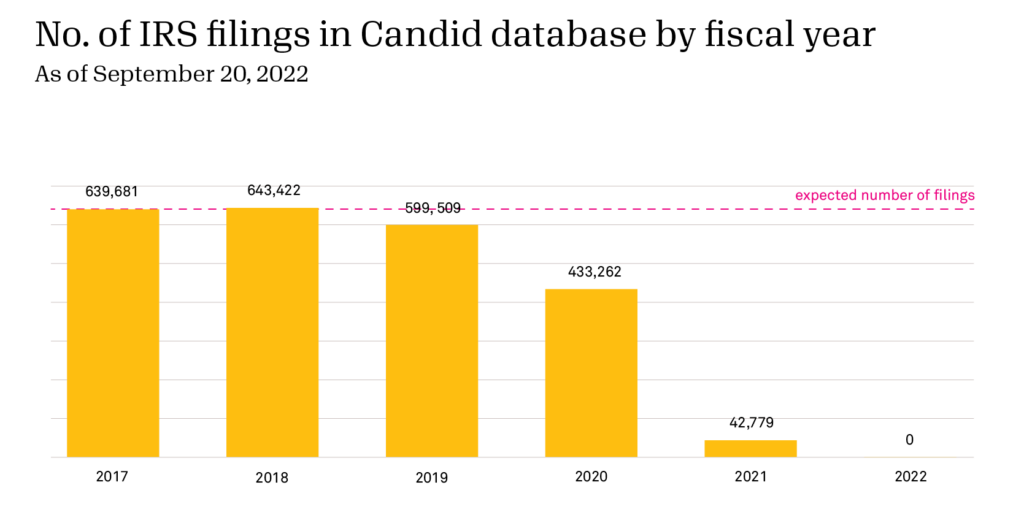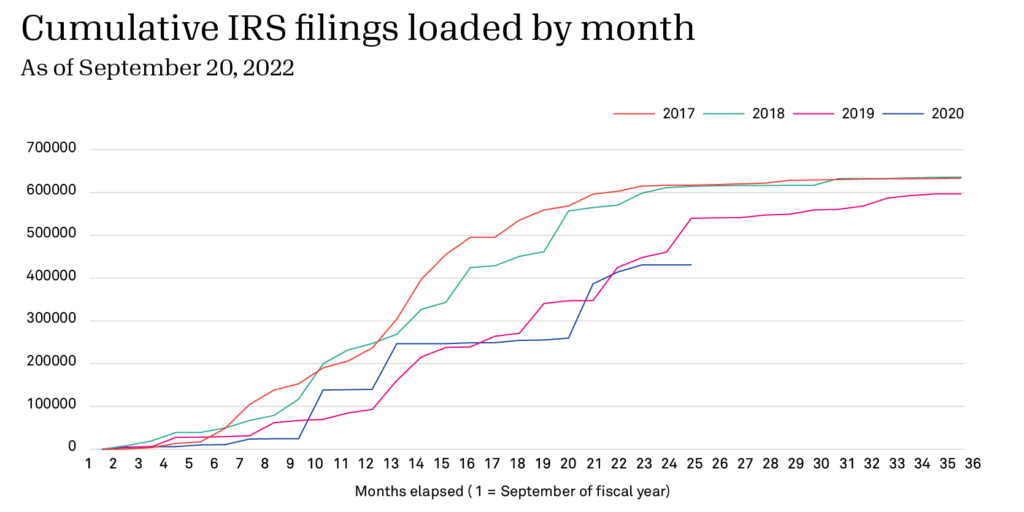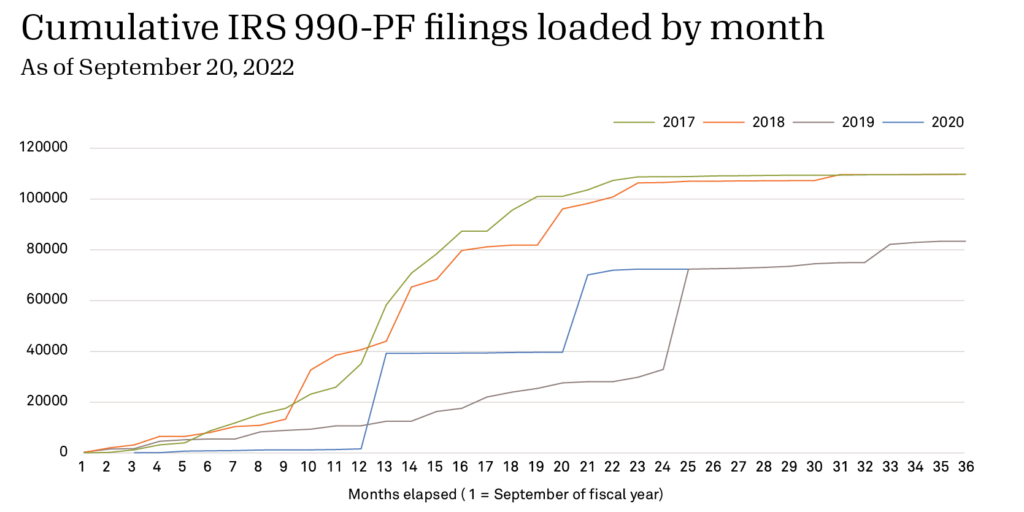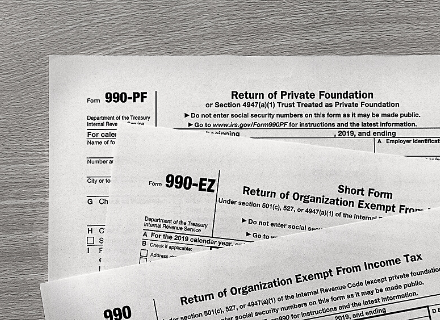The data/crisis catch-22: How the pandemic created a social sector data gap

Chances are you’re aware of how the COVID pandemic—and accompanying shortages, shutdowns, layoffs, and resignations—has wreaked havoc on supply and demand for everything from toilet paper to lumber to used cars. Unfortunately, social sector data has also been impacted. Staff working long hours responding to multiple crises have little time and energy for data collection and dissemination. This creates a data/crisis catch-22: While it’s important to have recent data when managing a crisis, it’s also harder to get.
Case in point: 990 data
IRS Form 990s, which U.S. tax-exempt organizations file annually, are a major source of data about nonprofits and foundation grantmaking in the United States. (For example, about 75% of Candid’s grants data is sourced from Forms 990). Before the pandemic, Candid usually received comprehensive IRS 990 data about nonprofits and foundations about 1.5–2 years after the close of a given year. After 2020, the time lag is closer to three years. While it’s hard to pinpoint the exact causes for these delays, there are likely multiple contributing factors. For one, busy and understaffed organizations are requesting filing extensions—the IRS expects roughly 762K tax-exempt extensions for fiscal year 2022. These extensions result in a backlog of files for the IRS, who are also understaffed. (The IRS division that processes 990s reported that staffing numbers are down 5.1%.) Additionally, the IRS is undergoing 990s process changes.i

The chart above shows the number of 990 filingsii that Candid has for years 2017–2022. Currently, we have a critical mass of filings for 2017–2018. We’re still waiting on tens of thousands of filings for 2019iii and about 30% of 2020 filings; collection of 2021 filings has just begun.
Isn’t this the same old story?
To some, this might feel like old news. “Due to the time lag associated with IRS 990 filings” is practically a mantra among social sector researchers and experts. To illustrate how recent delays compare to traditional delays, we plotted the number of IRS filings we’ve received each month for a given fiscal year (FY) in the chart below. Each trendline starts in September of a given year (recorded as “month 1,” as this is around the time we begin to receive filings) and continues for 36 months. It is important to remember that organizations typically file tax returns the following year, so FY 2019 (i.e., 990s submitted in 2020) is the first year impacted by COVID. For 2017 and 2018 fiscals, we’d received most filings after 24 months. In contrast, 2019 and 2020 fiscals are lagging at 24 months.

The delay is worse for data from private foundations (who file 990-PF forms). Currently, we only have about 76% of 2019 filings (compared to 2017/2018 numbers.)

What Candid is doing to counter the data/crisis catch-22
The 990 data shortage isn’t likely to end any time soon, nor is there any reason to believe that global crises will subside. Instead, we need to figure out alternative ways to get recent social sector data. At Candid, we’re doing this in four ways:
- Real-time data. Starting in 2020, Candid increased efforts to collect “real-time” data about grants and pledges sourced from the news, press releases, and funder websites. This data gives a glimpse into who’s funding what, where, right now, especially when it comes to large donors and headline-making giving. (Check out our blog on collecting data during a humanitarian crisis to learn more about how to use and interpret real time data.)
- Data-sharing partners. Over 800 funders share data directly with Candid—including 17 of the 25 largest U.S. foundations. These funders share information about their grant-making on a quarterly or annual basis, often before filing tax returns with the IRS. This effort is critical. To date, data sharing partners have shared 33,000 grants from fiscal year 2022, providing the sector with early indications of philanthropic trends and responses to current challenges.
- Rapid response pages. Since 2020, we’ve created and managed rapid response webpages where we capture and share out information and resources about a current issue or crisis as it unfolds. These webpages include news articles, grant announcements, giving trends, and organizations on the frontlines. (Visit our COVID-19, racial equity, and Ukraine philanthropic funding pages).
- Seals of Transparency. We invite all U.S. nonprofits to earn a Seal of Transparency by voluntarily providing information about their finances, operations, and activities on their Candid profile. Currently, roughly 84K Seal-holder nonprofits have shared information to help the sector stay informed.
We need your help
Responding effectively to the multiple crises affecting communities around the world requires information about who is doing what, where, right now. Here’s what you can do to help the social sector data gap:
- Funders: Join our data-sharing community. Sharing timely data about your grantmaking is an important step towards increasing the sector’s capacity to operate more efficiently, equitably, and effectively.
- Nonprofits: Claim your Candid nonprofit profile. Once you do, you can start earning your Seal by sharing the work you are doing and how you are doing it, helping funders more easily find you.
- Everyone: No matter your role, you can help educate others about the critical data gap we’re facing in the sector and urge others to share up-to-date, detailed information about their grantmaking and programs.
i The Taxpayer First Act, enacted July 1, 2019, requires tax-exempt organizations to file electronically. The law took effect between July 2019 and July 2021, depending on organization size and type. In June 2021, the IRS announced that they are experiencing delays in processing remaining paper returns.
ii This chart includes 990s, 990-EZs, and 990-PFs. It does not include 990-Ns, or nonprofits who do not file 990 forms with the IRS.
iii The IRS estimates how many types of different tax returns it will receive in a calendar year. While Candid counts filings by an organization’s fiscal year, the estimates provide a ballpark of the number of 990 filings we expect to receive in a given year.








Kate, Digital Communications Manager, Candid says:
Glad we were able to highlight the data lag. Organizations can also share their 990s directly via Candid profiles.
Kate, Digital Communications Manager, Candid says:
This is a great question. Yes, our team has noticed this as well. The IRS is also aware of the problem, and is currently implementing rules to prevent this from happening in the future.
Joyce Loeb says:
I have been wondering why our 990s after 2019 aren't on the site, now I know.
Jay Katz says:
Have you noticed that more foundations are not including lists of grants awarded or omitting that section? I'm seeing more returns that don't include that. Is that a matter of the IRS not having the staff/bandwidth/interest to ensure that's included? Or has there been another subtle change that makes that omission allowable?
Holly Klein says:
Thank you for all that you do for our next seven generations of integrity filled human beings on this beautiful earth!
Steven Edelman says:
Dear Cathleen and Anna,
Great article about the missing 1099s. Thank you for doing the research As the president of Connect360 and a CPA, I use 990s regularly to learn about nonprofit organizations we work with and prospects.
As you may know, Connect360 is a marketing and communications agency that works exclusively with nonprofits and nations leading distributor of public service announcements to broadcast stations, out of home, and digital media. I usually do my look-ups using Pro Publica. If there is a way I can be of help, please let me know.
Steve Edelman
Connect360 Multimedia
www.c360m.com
Kate, Digital Communications Manager, Candid says:
Hi H Yao, we don’t offer grants. But we do have resources to help you find grants. Check out our Knowledge Base for articles on the topic.
HOUNKPATI says:
COVID have distroyed a lot of things.
In my country there is a lot of boys and girls without parents and other things.
What Can we do to savez that cas.
Thanks.
H Yao
Brad Fulton says:
Great article! I appreciate the clear explanations and detailed information. Thanks, Brad